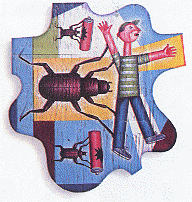Michael Fumento
Factual · Powerful · Original · Iconoclastic
Let Us Spray
January 01, 2000 · Michael Fumento · Forbes · EpaChildhood asthma rates, particularly among the nation’s poor, have rocketed — thanks largely to feces left by cockroaches. You’d think the feds would do anything they could to protect kids from these little fiends.
Instead, the Environmental Protection Agency is phasing out the most effective roach killer — the insecticide chlorpyrifos — for use in household products. Made chiefly by Dow AgroSciences under the trade name Dursban, it’s used in more than 800 products and is applied an estimated 20 million times a year to homes and schools.

Why? Because the EPA has determined that high concentrations of chlorpyrifos may cause brain damage in the children of ... rats. Extrapolating the case to kids is a scientifically indefensible — and an economically reprehensible — action.
The usual maximum allowable exposure to a pesticide is ten times lower than the highest level shown to have no effect on human test subjects, if human data are available. In this case there were three clinical studies by Dow that showed no adverse effects on people, even at the highest doses. But the agency looked only at animal studies, also by Dow, where it found no harmful results at similar exposure levels when adjusted for body weight.
Using animal-only data allowed the EPA to add an additional tenfold factor to account for possible disparate effects on humans and animals. In moving to ban chlorpyrifos it added yet a third tenfold safety factor, reducing the maximum human exposure to 30 nanograms per kilogram of body weight per day.
Protecting children is a vital mission. But the EPA unfairly drew its conclusions on the basis of one out of more than 100 studies Dow has submitted over the past few years. One result showed reduced weight and higher death rates in rat offspring (or pups) when pregnant mothers had massive doses of chlorpyrifos pumped directly into their stomachs. "The mothers were all flagrantly poisoned, and it shouldn’t surprise anyone that they were less able to nourish their offspring as a result," says Dr. Michael Mullins, a toxicologist at Washington University in St. Louis.
A second result showed that one part of the brain of rat offspring whose mothers had chlorpyrifos pumped into their bellies was slightly thinner than the control. But this occurred at the middle dose, not at the high dose. Mullins thinks it was either a statistical fluke or a problem in accurately measuring something so tiny.
"The losers in this are the public," says Robert Krieger, a toxicologist at the University of California, Riverside. "No doubt Dow and the EPA will do fine." Not to mention the roaches.
